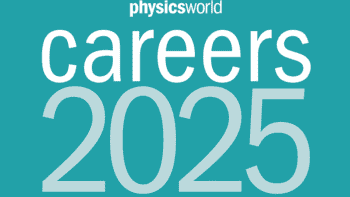Nine Crazy Ideas in Science: A Few Might Even Be True
Robert Ehrlich
2001 Princeton University Press 288pp £16.50/$24.95hb

Few things in life are utterly black or white. Even scientific ideas come in shades of “truth”, which is arrived at differently in different kinds of science. There are other gradations too, starting with theories that we are pretty damn sure are right and that we accept without question, such as Newton’s three laws of motion. Our attitude to these differs subtly from those that we also think are correct but might wish were not, if only to make a richer universe, such as the relativistic limitation on faster-than-light travel. At the opposite extreme are ideas that seem wrong to most scientists but are espoused by a minority (sometimes a minority of one) and may be accepted by non-scientists too, like the belief that AIDS is not caused by the HIV virus.
All of these issues enter into Robert Ehrlich’s Nine Crazy Ideas in Science. The title could imply that the book provides no more than a series of chuckles at laughably inane theories, but Ehrlich is serious. In critically examining more-or-less marginal ideas drawn from several fields of science, he contemplates the meaning of scientific truth, how emotions and personal agendas influence scientists, and how unproven ideas can do harm. He also notes that some valid theories, such as quantum physics, sound plenty weird, and that we need to learn how to recognize those seemingly crazed ideas that just happen to be true breakthroughs.
Ehrlich already does some filtering, for he makes “crazy” a technical term. According to him, a “crazy” idea violates no known fundamental laws of nature, whereas a “nutty” one blithely disregards those laws. So you’ll find no perpetual motion machines here. Instead, you’ll read about the idea that there was no big bang, that our solar system has two suns, and that the Earth’s coal and oil did not arise from biological sources. You’ll also weigh up the possibilities that time travel can be realized, and that faster-than-light particles exist (Ehrlich’s own field of research). In addition to the contrary opinion about AIDS, you’ll consider the premises that low doses of nuclear radiation are good for people, that exposure to the Sun is beneficial and that more guns lead to fewer crimes.
For each notion, Ehrlich gives the accepted and minority views, or the differing views where there is no overwhelming consensus. He then presents the background of the relevant scientists, before giving point-by-point comparisons showing what evidence supports which view, and how strongly. Ehrlich writes clearly and simply, backed up by figures and ample references. Except for a few difficult moments as he gets into details, readers who are not experts in the areas will still find themselves grasping the essential issues.
It’s instructive to see the “tools of truth” that Ehrlich uses. Research on sunlight, nuclear radiation and the human effects of guns necessarily relies on statistical correlations, rather than direct cause-and-effect relationships. Ehrlich’s approach to these statistics reminds us of how important it is to go back to original sources. He shows how data change remarkably “in translation”; that is as interpreted and displayed by succeeding layers of analysts. Of course, the original investigator may also consciously or unconsciously put spin on the data, which is one reason that experiments are supposed to be capable of replication.
Ehrlich’s crazy ideas in the physical sciences tend to arise differently. Here they start with a theoretical basis that leads to predictions that may be experimentally verifiable. For instance, Einstein’s equations show that supposed faster-than-light particles (dubbed “tachyons”) would have a mass m that would be an imaginary number, so that m2 would be negative. You might think this pretty definitively eliminates all known elementary particles, but here too statistics steps in. According to Ehrlich, the statistical uncertainty in measurements of the supposed zero mass of neutrinos allows the possibility that m2 is actually negative – and so keeps the idea alive.
Data analysis also drives the notion that our Sun has a binary companion star so distant that astronomers have yet to spot it. The companion periodically affects the Earth: each time it orbits through the Oort cloud – the swarm of comets surrounding the solar system – it shakes loose comets. These rain down meteorites that extinguish earthly life, as in the demise of the dinosaurs 65 million years ago. Analysis of the geological record suggests that similar extinctions occur every 26 million years, supposedly correlated with the motion of our second sun. But, as Ehrlich notes, finding periodicity in a set of imperfect data is a notoriously tricky endeavour that is hard to view with total confidence.
Lord Rutherford once said that “if your experiment needs statistics, you ought to have done a better experiment”. But often in matters of health and social policy, we can’t do the better experiment, and statistics are all that we have. As science journalists know to their despair, however, it is very hard to convey to non-experts the line between unthinking acceptance of all “scientific” studies and understanding that even valid results carry uncertainty. Ehrlich’s book can help practising scientists, students and ordinary citizens to think critically about scientific evidence that may affect their lives.
Are there any gems among the nine ideas? Ehrlich rates the believability of each on a scale from zero cuckoos – meaning it has sufficient merit to make us say “why not?” – to four cuckoos, meaning “certainly false”. I won’t reveal his ratings except for his evaluation of the potentially harmful belief that AIDS is not caused by the HIV virus, which could lead people to abandon effective treatment and has influenced the politics of AIDS in Africa. This notion receives short shrift. Ehrlich gives it three cuckoos: “Almost certainly not true.”
I’m delighted to report, though, that the average cuckoo rating for the crazy ideas lies between “probably not true, but who knows” and “very likely not true”. This leaves leeway for science to continue as a “work in progress”, as Ehrlich calls it, and for some lovely future surprises. Myself, I’m holding out for evidence that gives the myth of Atlantis a rating of 3.9 – anything but that deadly, definitive four cuckoos.


